
If you wish this
program to be sent to your or your friends e-mail address,
please get a subscription (totally free of charge, and no
advertisements will be sent).
I would like to
get a subscription to
The Fourth Dimension in
Landscape Design>>>>>>>
I would
like to propose for my friend>>>>>>
|
Palm Centre Plant of the
Month
DECEMBER 2010 |
|
|
|
Asphodelus aestivus
is a member of the Lily family of plants - the
Liliaceae - and is extremely common throughout the
Mediterranean countries. It is native to South
Europe,. North Africa and East Asia. Often occurring
alongside hollow-stemmed asphodel which has a darker
and more pronounced pink stripe on its flower petals
and usually blooms slightly later than common
asphodel. Muğla-Antalya region Common Asphodel is often found by
Sea Squirll Urginea maritima.
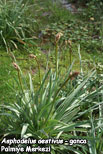 Common
Asphodel
Often appearing as early as December, common
asphodel can form vast stands that appear to
dominate large areas. It is fond of disturbed and
abandoned agricultural land but can appear almost
anywhere, including close to the sea. This beautiful
wildflower blooms from January onwards and is at its
best in February and March. It is seldom seen after
April but can occasionally be found flowering right
through until early June. Common
Asphodel
Often appearing as early as December, common
asphodel can form vast stands that appear to
dominate large areas. It is fond of disturbed and
abandoned agricultural land but can appear almost
anywhere, including close to the sea. This beautiful
wildflower blooms from January onwards and is at its
best in February and March. It is seldom seen after
April but can occasionally be found flowering right
through until early June.
An evergreen perennial
growing to 1m by 0.3m. , it tolerates temperatures
down to -10°C]. The flowers are hermaphrodite.
The plant prefers light
(sandy) and medium (loamy) soils, requires well-drained
soil and can grow in nutritionally poor soil. The
plant can be grown in asidic or basic soils. It can
grow in semi-shade or in sun. It can tolerate
drought.
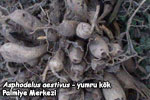 Root, seed and stem of
the Asphodelus aestivus are edible.
Tuber cooked, rich in starch. Dried and boiled in
water it yields a mucilaginous matter which can be
mixed with grain to make a nutritious bread. Boiling
destroys the acrid principle in the tubers,
rendering them quite pleasant to eat. Flowering
stalk cooked and seed roasted. Root, seed and stem of
the Asphodelus aestivus are edible.
Tuber cooked, rich in starch. Dried and boiled in
water it yields a mucilaginous matter which can be
mixed with grain to make a nutritious bread. Boiling
destroys the acrid principle in the tubers,
rendering them quite pleasant to eat. Flowering
stalk cooked and seed roasted.
The root, gathered at
the end of its first year, is acrid, antispasmodic,
diuretic, emmenagogue. It was used in the treatment
of several diseases by the Greeks and Romans, but is
not employed in modern medicine.
In Persia, glue is made
with the bulbs, which are first dried and then
pulverized. When mixed with cold water, the powder
swellls and forms a strong glue. This glue is used
by bookmakers and shoemakers.
Asphodelus aestivus
are disliked by grazing animals, A severe neurologic
syndrome accompained by intense neuronal
pigmentation was described in sheep exposed to
Asphodelus aestivus in Turkey.
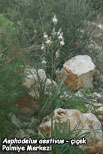 Propagation: Seed sow
March-Aril in a greenhouse and only just cover the
seed. Germination usually takes place in 1 3
months at 15°C. When they are large enough to handle,
prick the seedlings out into individual pots and
grow them on in the greenhouse for at least their
first winter. When the plants are large enough to
handle, plant them out into their permanent
positions in late spring or early summer. Division
in early spring or autumn. Propagation: Seed sow
March-Aril in a greenhouse and only just cover the
seed. Germination usually takes place in 1 3
months at 15°C. When they are large enough to handle,
prick the seedlings out into individual pots and
grow them on in the greenhouse for at least their
first winter. When the plants are large enough to
handle, plant them out into their permanent
positions in late spring or early summer. Division
in early spring or autumn.
The Common Asphodel
makes attraction with thin, long and green
leaves all year around and with the attractive star-shaped
flowers in spring.
It may be used together with other kind of bulbs as
a group. Especially in geofit gardens can be used
with, summer and autumn flowering bulbs. One of the
best combinations is the use of
Common Asphodel
with Sea Squirll
as in the native lands. |
|
Palm Centre Plant of the
Month NOVEMBER 2010 |
|
|
|
Urginea
is a genus in the
Hyacinthaceae family.
Urginea is consist of about 100
species of bulbous perennials. They are mainly found
on dry, rocky hillsides, on sandy soils near coasts
or on plains or savannah, mostly in tropical Africa,
with a few in the Mediterranean. They have narrowly
linear, basal leaves, and are grown for their star
or saucer shaped flowers. Produced in long, erect,
dense racemes on leafless stems in summer and autumn.
Some species are frost hardy others are not, so in
cold areas, frost hardy species should be used.
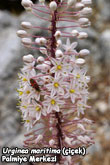 Urginea
maritima
is the giant among all Mediterranean geophytes. In
spite of the specific name, this species is by far
more common inland than on the sea.
Sea Squill
grows in open spaces on shallow stony soils, with
the bulbs totally above the ground. Several layers
of papery tunics (like at onion -Allium
cepa-)
protect the bulbs from the sun
and occasional fires don't harm them at all. Rodents
don't eat the bulbs since they are poisonous. The
bulbs split dichotomously from the apex rather than
forming basal offsets and in time they grow to
massive clumps up to 20 heads, each one reaching up
to 30cm in diameter and 60cm high. Two forms are
known. The one with brown reddish outer tunics, is
sometime referred as var.
rubra.
This form is usually found inland and gets to be a
bigger size. The other form has whitish outer tunics
and is referred as var.
alba.
Both forms have whitish inner tunics. Variability is
also present in the flowers, which appear from the
bare bulbs in late August. Some individuals have
white flowers with a distinct pink midrib on the
tepals and in extreme cases the flowers are all
pinkish; others have totally white flowers. Flower
stalks grow to 100cm high. Leaves are dull green
with a bluish waxy bloom and are a towering presence
in winter, above seasonal short grasses. Urginea
maritima
is the giant among all Mediterranean geophytes. In
spite of the specific name, this species is by far
more common inland than on the sea.
Sea Squill
grows in open spaces on shallow stony soils, with
the bulbs totally above the ground. Several layers
of papery tunics (like at onion -Allium
cepa-)
protect the bulbs from the sun
and occasional fires don't harm them at all. Rodents
don't eat the bulbs since they are poisonous. The
bulbs split dichotomously from the apex rather than
forming basal offsets and in time they grow to
massive clumps up to 20 heads, each one reaching up
to 30cm in diameter and 60cm high. Two forms are
known. The one with brown reddish outer tunics, is
sometime referred as var.
rubra.
This form is usually found inland and gets to be a
bigger size. The other form has whitish outer tunics
and is referred as var.
alba.
Both forms have whitish inner tunics. Variability is
also present in the flowers, which appear from the
bare bulbs in late August. Some individuals have
white flowers with a distinct pink midrib on the
tepals and in extreme cases the flowers are all
pinkish; others have totally white flowers. Flower
stalks grow to 100cm high. Leaves are dull green
with a bluish waxy bloom and are a towering presence
in winter, above seasonal short grasses.
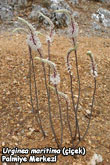 In
human phytotherapy the dried bulb of the white
variety of Urginea maritimia (Squill) is used orally
diuretic, emetic, expectorant, ve cardiotonic. Daily
oral doses for adults range from 30 to 500mg. In
human phytotherapy the dried bulb of the white
variety of Urginea maritimia (Squill) is used orally
diuretic, emetic, expectorant, ve cardiotonic. Daily
oral doses for adults range from 30 to 500mg.
Urginea maritimia is easly grown in a dry, sunny
position in sandy soil. Propagation is from seeds or
dividing the bulbs.
The squill makes attraction with large, showy leaves
in winter and with the attractive star-shaped
flowers in autumn.
It may be used together with other kind of bulbs as
a group. Especially in geofit gardens the spring and
summer garden flowers in autumn and winter flowering
species are used in conjunction with the appearance
of leaves and complements. |
|
Palm Centre Plant of the
Month
OCTOBER 2010 |
|
|
|
|
.jpg) Ruella
brittoniana
is native to Mexico, but is now wildly dispersed
through the Southeast United States. In Florida,
where it is a perennial, it is considered an
invasive plant. Since it is only hardy thru zone 8,
it is an annual in Missouri. Commonly known as
Mexican Petunia. The genus name honors Jean de
la Ruella (1474-1537) a French herbalist.
Ruella brittoniana is called Mexican
Petunia, but it is not even related to petunias. Ruella
brittoniana
is native to Mexico, but is now wildly dispersed
through the Southeast United States. In Florida,
where it is a perennial, it is considered an
invasive plant. Since it is only hardy thru zone 8,
it is an annual in Missouri. Commonly known as
Mexican Petunia. The genus name honors Jean de
la Ruella (1474-1537) a French herbalist.
Ruella brittoniana is called Mexican
Petunia, but it is not even related to petunias.
Ruella is a member of the Acanthaceae.
The lance-shaped leaves are
deep green
to 1530 cm in length
and 12 cm wide. Stems are
strong, semi woody, reaching about 1 meter tall.
Blooms are a vibrant purplish blue, trumpet shaped,
and 3-5 cm. The flowers are borne on the tips of the
stems. Each bloom lasts only one day, but the
succession of non-stop blooms makes it a very showy
plant.
.jpg) Varieties
with white, pink, and many shades of blue are
available, as are dwarf versions that form clumps
that are about 2025 cm in height. Mexican petunia
is very showy when in full bloom due to the clouds
of admiring butterflies that swarm about the plants.
Ruellia is essentially disease and pest free, so
its very environmentally friendly. Even better,
hummingbirds, butterflies and bumblebees love this
plant! Varieties
with white, pink, and many shades of blue are
available, as are dwarf versions that form clumps
that are about 2025 cm in height. Mexican petunia
is very showy when in full bloom due to the clouds
of admiring butterflies that swarm about the plants.
Ruellia is essentially disease and pest free, so
its very environmentally friendly. Even better,
hummingbirds, butterflies and bumblebees love this
plant!
Culture:
Prefers fertile soil with moisture, but is very
adaptable.
Ruellia brittoniana
tolerates high heat, is drought tolerant, and can
endure high humidity. Mexican Petunia prefers
full sun, but will tolerate shade (it just doesnt
flower as profusely).
After flowering, cut back stems about halfway for a
new crop. Ruellia
brittoniana
is an easy to grow plant with strikingly colored
flowers that is seldom bothered by disease or pests.
It blooms enthusiastically throughout the hottest
time of the year.
Propagation is very easy. Clumps can be divided;
stem cuttings easily root in moist soil or sand; and
seeds often self sow.
The use in landscape:
Ruellia brittoniana prefers
sun to part shade. The quantity of blossoms is
related to the amount of light the plant receives.
The more direct sunlight the more flowers with fewer
flowers appearing in overcast conditions or when
grown in shadier conditions.
Mexican Petunia
prefers average to moist soil. It is a water plant
that becomes very aggressive with access to abundant
moisture. Survives dry spells once established.
Mexican petunia can be grown indoors as a houseplant
in bright light. When growing Mexican Petunia
indoors water freely when in active growth but water
only when dry in winter.
|
|
Palm Centre Plant of the
Month
SEPTEMBER 2010 |
|
|
|
Aloe variegata
is one of the best known, and most distinctive
of the South African aloes. The genus name
Aloe is derived from the Arabic,
alloch literally meaning bitter or
bitter sap which is descriptive of aloe sap. The
specific epithet
variegata
is Latin and means irregularly
spotted, referring to the attractive spotted
bands on the leaf surfaces. The characteristic
white spots on the leaf surfaces are most
attractive and resemble the spots on a
partridge's breast, hence the common name.
Aloe variegata
is found over large areas in the arid or semi-arid
regions of South Africa and in the southern
parts of Namibia.
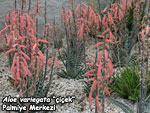 Aloe
variegata
is classified as a dwarf aloe and is grouped
together with various other aloes that reach a
height of no more than 250 mm. Plants may be
found as solitary individuals but are most
commonly encountered in small groups of up to 7
or 8 plants which form dense rosettes through
underground suckers. The leaves are lanceolate-deltoid,
about 1520 cm long, and are arranged in three
ranks of 6-8 leaves each. The leaf colour may be
variable depending on the habitat and climatic
conditions: deep green in good years or
chocolate brown when plants have experienced
drought stress. White markings, spots or
blotches that form irregular transverse bands,
decorate both surfaces of the densely
overlapping leaves. Aloe
variegata
is classified as a dwarf aloe and is grouped
together with various other aloes that reach a
height of no more than 250 mm. Plants may be
found as solitary individuals but are most
commonly encountered in small groups of up to 7
or 8 plants which form dense rosettes through
underground suckers. The leaves are lanceolate-deltoid,
about 1520 cm long, and are arranged in three
ranks of 6-8 leaves each. The leaf colour may be
variable depending on the habitat and climatic
conditions: deep green in good years or
chocolate brown when plants have experienced
drought stress. White markings, spots or
blotches that form irregular transverse bands,
decorate both surfaces of the densely
overlapping leaves.
The inflorescence of Partridge Breast Aloe
is a raceme and is mostly branched with hanging
flowers that are quite abundant and beautiful
after good rains. Flowers may vary from a flesh-pink
to red, rarely yellow. Flowers are 3545 mm long
and flowering time is July to September in their
native habitat, however they flower at January-March
in our part of the world. The fruit is a capsule
that splits into three when ripe. Seeds produced
in abundance.
Aloe variegata
is best grown from seeds. Seeds must be sown as
fresh as possible. Also can be produced by
removing off springs.
Remember that
Aloe variegata
is adapted to arid and semi-arid
conditions. It is thus very easy to kill plants
through overwatering and poor drainage. It likes
sun but also can tolerate to semishade.
It can withstand frost down to -40C,
provided it is kept dry, lower temperatures kill
the plant. Best can be used in groups within a
rock garden, or can be used at pots as a pot
plant at places with sufficient light. |
|
Palm Centre Plant of the
Month
JULY 2010 |
|
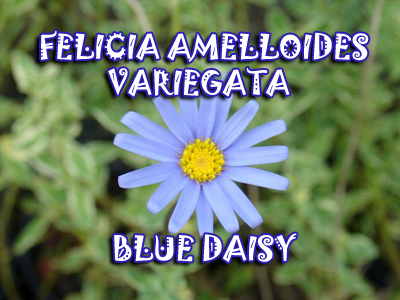 |
|
BLUE DAİSY - FELİCİA AMELLOİDES (AGATHAEA
AMELLOİDES )
Felicia
is a genus of about 80 species of annuals,
perennials and evergreen subshrubs and (rarely)
shrubs found in open sunny habitat in the
Arabian Peninsula and tropical and southern
Africa. Some are frost hardy, others are frost
tender.
They are grown for their
mass of daisy-like, mainly blue flower heads
with yellow disc-florets, often borne over long
periods in summer.
BLUE
DAİSY
Felicia amelloides
This Felicia is usually a perennial,
evergreen shrublet, about 0,5 x 0.5 m. It is
densely branched and frequently has dark reddish
stems. The flowerheads are typical of the
Asteraceae
and are about 30 mm in diameter and are borne on
naked stalks up to 180 mm long. Unlike many
daisies, these do not close at night.
In Pretoria gardens they flower almost
throughout the year, with most flowers in spring
and early summer. They live a long time, usually
at least five years, under normal conditions.
The blue felicia bush withstands light frost.
Needs a light, sandy or gravelly soil with good
drainage and much compost if possible. Give a
dressing of fertilizer for flowering plants (with
ratio of N:P:K = 3:1:5) or a general fertilizer
(ratio of 2:3:2) and mix some super phosphate
into the soil. Water it regularly, but
moderately, especially during the dry season.
Felicia amelloides
propagated by seed or cuttings in spring. The
latter method is quicker and the resultant
plants should flower in about a year. Once
established, Blue Daisy is quick growing
and can look good for many years. When young, it
can be made to bush well if the main shoots are
pinched out. Light pruning during the summer
will encourage more crops of flowers. To improve
appearance, cut off the many old flowers. After
about three years, it may need to be cut back if
it gets straggly. If it becomes frost-damaged,
it will usually resprout and flower a little
later than usual. It does not seem to suffer
from pests very much, making it even more
carefree for the gardener.
 Use
in Landscape : This felicia could make an
effective base for
Strelitzia
reginae (crane flower) in
semishade or sun. A lovely contrast can be
achieved by mixing plants with different leaf
types. The blue felicia bush goes well with
bulbs like
Agapanthus
,
Eucomis
autumnalis (Pineapple
Flower),
Hemorocallis fulva
(Day Lily)
. Another type of contrast, is the
inclusion of grey or whitish-leaved plants among
the green ones. They have a cooling effect and
look good in all seasons. Examples are
Gazania rigens (Trailing Gazania),
Helichrysum
petiolare,
Ajania pacifica. The darker leaved
Euryops pectinatus
(grey euryops) or dark red colored
Alternathera dentata ruby would also give
an interesting contrast. Use
in Landscape : This felicia could make an
effective base for
Strelitzia
reginae (crane flower) in
semishade or sun. A lovely contrast can be
achieved by mixing plants with different leaf
types. The blue felicia bush goes well with
bulbs like
Agapanthus
,
Eucomis
autumnalis (Pineapple
Flower),
Hemorocallis fulva
(Day Lily)
. Another type of contrast, is the
inclusion of grey or whitish-leaved plants among
the green ones. They have a cooling effect and
look good in all seasons. Examples are
Gazania rigens (Trailing Gazania),
Helichrysum
petiolare,
Ajania pacifica. The darker leaved
Euryops pectinatus
(grey euryops) or dark red colored
Alternathera dentata ruby would also give
an interesting contrast. |
|
|
Palm Centre Plant of the
Month
JUNE 2010 |
|
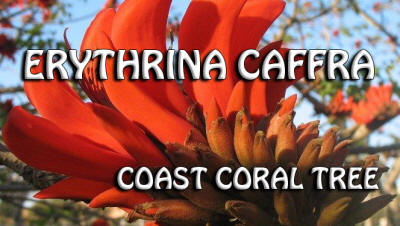 |
|
Erythrina
is bellong to Fabaceae (legume) family and known
as the red genus (erythros which means red and
alludes to the bright red flowers and seeds).
The genus
Erythrina
is a group of shrubs and trees which
have their origin is in South Africa, West
Indies, Brazil, and Australia. The genus
contains over 170 species.
The coastal coral tree is an ideal garden plant
and, because of its unique appearance, has
continued to draw the interest of botanists,
horticulturist, nature lovers, and the general
gardening public for many decades.
Erythrina caffra is widely
loved for its warm red to scarlet-coloured
flowers. Its popularity can be ascribed to its
ease of cultivation and long flowering period.
Erythrina caffra
is a medium-sized to large deciduous tree, Its
size depends largely on the climate and soil
conditions. It is normally 810 m heigh, but may
reach a height of 20 m in coastal and forested
regions where the conditions are optimal. This
species forms a round-headed, spreading canopy
and has a beautifully light green appearance
when in leaf.
As with all other erythrinas, the leaves are
typically trifoliate (three leaflets), which are
broadly ovate (egg-shaped) to elliptic (oval and
narrowed to rounded ends, widest at or about the
middle), the terminal leaflet is the largest.
The leaflet petiole (leaflet stalk) is with or
without prickles. The leaves closely resemble
those of a sister species,
Erythrina lysistemon (sacred
coral tree). When not in flower it can be
rather difficult to tell the two species apart.
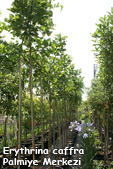 Flowering
starts from cold winter and carries on
throughout spring. The flowers are spectacular
and are produced before the leaves appear and
carried in large clusters at the ends of thick,
stalks. Superficially they are shaped like
cockscombs. The flower has a short, broad,
standard petal, the lower half of which curves
upward to expose the stamens and they give the
flower a bewhiskered appearance. When compared
to the flowers of
Erythrina lysistemon,
the latter have longer, narrower standard petals
which fold to enclose the stamens. There is also
a difference in colour between
E. lysistemon
and
E. caffra.
E caffra
has mainly orange-scarlet flowers,
in contrast to the clear scarlet of the northern
species. Flowering
starts from cold winter and carries on
throughout spring. The flowers are spectacular
and are produced before the leaves appear and
carried in large clusters at the ends of thick,
stalks. Superficially they are shaped like
cockscombs. The flower has a short, broad,
standard petal, the lower half of which curves
upward to expose the stamens and they give the
flower a bewhiskered appearance. When compared
to the flowers of
Erythrina lysistemon,
the latter have longer, narrower standard petals
which fold to enclose the stamens. There is also
a difference in colour between
E. lysistemon
and
E. caffra.
E caffra
has mainly orange-scarlet flowers,
in contrast to the clear scarlet of the northern
species.
The fruits are dark, in cylindrical pods, which
are up to 65 mm long. The pods split to release
the small, shiny, coral-red seeds. As seeds
become older, they turn a rich red-brown. The
flowers of Erythrina caffra do not produce any
fragrance, and only colour, in combination with
the reward of nectar, which the tree produces in
abundance, is used to attract pollinator birds
in their native forests.
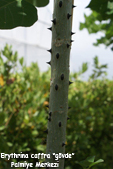 Erythrina
caffra
is a subtropical tree that occurs in the warm
and frost-free to light frost coastal regions of
the Eastern Cape and northern KwaZulu-Natal. The
trees are found in various soil types from wet,
well-drained, humus-rich soils to dry, clay
soils. Erythrina
caffra
is a subtropical tree that occurs in the warm
and frost-free to light frost coastal regions of
the Eastern Cape and northern KwaZulu-Natal. The
trees are found in various soil types from wet,
well-drained, humus-rich soils to dry, clay
soils.
The branches of Coast Coral Tree are
armed with prickles, which might serve as
protection to herbivores especially when trees
are still young. Fully grown trees are fairly
drought resistant and can withstand several
degrees of frost. In areas where there is severe
frost, it may well grow but chances are that
they won't flower. The seeds of all
erythrinas are said to be poisonous and the
leaves of
Erythrina caffra
are known to have poisoned cattle.
As with all erythrinas, the Coast
Coral Tree is easily cultivated by seeds.
Another effective and more instant propagation
method is by making giant hardwood cuttings
called truncheons. These are branches measuring
at least 40 mm in diameter. This method works
very well and cuttings must be taken just before
the trees come out of dormancy which is late
winter or early spring.
Erythrina
caffra should be planted in sunny
places in well-drained soil.
In landscape terms in the milder areas of our
region
can be used
as edging for a patio, or as a specimen plant or
in small groups.
They can also be used in large rock gardens. |
|
|
Palm Centre Plant of the
Month
MAY 2010 |
|
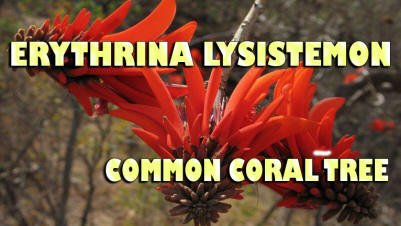 |
|
Erythrina
is bellong to Fabaceae (legume) family and known
as the red genus (erythros which means red and
alludes to the bright red flowers and seeds).
The genus
Erythrina
is a group of shrubs and trees which
have their origin is in South Africa, West
Indies, Brazil, and Australia. The genus
contains over 170 species.
Erythrina lysistemon:
Common Coral Tree,
is a lovely, small to medium-sized, deciduous
tree with a spreading crown and brilliant
scarlet red flowers. Height of this showy tree
is not more than 10 meters. Naturaly it is found
at southern and eastern Africa. Erythrina
lysistemons dazzling flowers have made
it one of the best known and widely grown South
African trees.
The bark is smooth and dark gray to gray-brown.
Short, hooked prickles are sparsely and randomly
scattered on the trunk and branches. The leaves
are trifoliolate (compound leaves with 3
leaflets), and each leaflet is large, usually up
to 17 x 18 cm. The common coral tree blooms in
early spring and it produces its flowers before
its new leaves or just as the leaves begin to
show.
The flowers are a beautiful clear scarlet and
are carried in short, dense heads, about 9 cm
long, on long, thick stalks. The flowers produce
abundant nectar that attracts many nectar-feeding
birds and insects. The fruit is a slender, black
pod that can be 15 cm long and is sharply
constricted between the seeds. The pod splits
while still attached to the tree to release
bright red 'lucky bean' seeds.
Erythrina lysistemon
is thought to have both medicinal and magical
properties by many people in South Africa.
Erythrina lysistemon does contain a
large number of alkaloids that are known to be
highly toxic, but its use in traditional
medicine suggests that they have antibacterial,
anti-inflammatory and analgesic effects.
Erythrina lysistemon
is often confused with Erythrina caffra,
the Coast Coral Tree. Erythrina
caffra grows in the coastal and
riverine fringe forests It is generally taller
than Erythrina lysistemon, the
flowers are orange-scarlet, and a cream-flowered
form is occasionally seen, and the standard
petal is shorter and broader so that the stamens
stick out of the flower giving it a whiskered
look. In most other respects they are very
similar, and were in fact regarded as the same
variable species for many years and, when not in
flower, are difficult to tell apart.
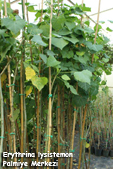 Erythrina
lysistemon
is a fast-growing, undemanding tree. It does
best in fertile, well-aerated and well-drained
soils. It is fairly drought-tolerant, but
performs better if given water during summer. It
is sensitive to cold and grows best in frost
free gardens, but will survive in regions with a
winter minimum of -7 ºC/20 °F provided protected
from frost when young. Erythrina
lysistemon
is a fast-growing, undemanding tree. It does
best in fertile, well-aerated and well-drained
soils. It is fairly drought-tolerant, but
performs better if given water during summer. It
is sensitive to cold and grows best in frost
free gardens, but will survive in regions with a
winter minimum of -7 ºC/20 °F provided protected
from frost when young.
Erythrina lysistemon
is easily propagated from seed, cuttings and
truncheons. Seed is sown in spring and summer,
in a well-drained, general-purpose potting soil,
placed in a warm but shaded spot and kept moist.
Cuttings are best taken in spring to summer, and
truncheons in late winter to spring. Truncheons
are made from part of or even an entire branch
which is left to dry and heal for a few days,
then planted into a pot filled with sand or even
directly into the soil where the plant is to be
grown, and kept damp but not wet. If a plant has
to be transplanted, this is best done whilst it
is dormant, during winter.
The common coral tree is an excellent specimen
tree for gardens and parks and is very effective
planted in avenues or for street plantings. It
is particularly recommended for that spot in the
garden where you need sun in winter and shade in
summer. |
|
|
Palm Centre Plant of the
Month APRIL
2010 |
|
Cinnamomum:
This genus of
Lauraceae family,
consist of around 250 species of
evergreen trees from tropical and subtropical Asia and
Australia with smooth, strongly veined leaves. Highly
aromatic compounds are present in the leaves, twigs and
bark of all species. Most species require tropical or
subtropical conditions, with fairly high rainfall, only
Cinnamomum camphora
is adaptable to warm-temperate climates.
CAMPHOR TREE
or CAMPHOR LAUREL - CINNAMOMUM CAMPHORA
Camphor Tree
is a large
evergreen
tree that grows up to 2030 meters tall.
Cinnamomum camphora is native to
Japan, China, Taiwan, Vietnam, Korea,
where it is also cultivated for camphor and timber
production.
Invasive in Australia, Southern USA, Caribbean Islands,
Southern Africa and Tanzania, Ghana, Vietnam and Hawaii.
Introduced but not invasive in Southern Europe,
Madagascar, Canary and Madeira Islands.
The leaves have a glossy, waxy appearance and smell of
camphor when crushed.
A quick and easy method of identifying camphor is by
crushing the leaves or peeling a twig or bark. This will
release oils and the scent of camphor. Camphor is an
evergreen tree with oval to elliptical leaves, arranged
alternately on the stem. Slender twigs are initially
green but change to reddish brown.
In spring it produces bright green foliage (new emerging
ones are red in color) with masses of small white
flowers. It produces clusters of black
berry-like
fruit around one centimetre in diameter. It
has a pale
bark that is very rough and fissured
vertically. Camphora oil was used medicinally and was
also an important ingredient in the production of
smokeless gunpowder.
Cinnamomum camphora was introduced to
Australia in 1822 as an
ornamental tree for use in gardens and public
parks. It has been declared a
noxious weed in many parts of
Queensland and
New South Wales. Its massive and spreading
root systems disrupt urban drainage and sewerage systems
and degrade river banks. Its leaves have a very high
carbon content, which damages water quality
and freshwater fish habitats when they fall into streams
and rivers. The camphor content of the leaf litter helps
prevent other plants from germinating successfully. The
seeds are attractive to birds and pass intact through
the digestive system, ensuring rapid distribution
Propagate
by seed. USDA Hardiness Zone 9B to 11. Camphor trees
grow in full sun to partial shade. They tolerate clay,
loam, sand, slightly alkaline to acidic soils, and
drought. It can take moderate frost, without suffering.
We have seen some, in Yalova and İstanbul.
In landscaping terms, they can be planted soliter or in
groups as shade trees. Large trees are very like to
ficus trees, superior for them, they can be grown in
colder climates. They also can be planted as avenue
trees in both sides of the streets.
Camphor is a white crystalline substance, obtained from
the tree Cinnamomum camphora. Camphor has been
used for many centuries as a culinary spice, a component
of incense, and as a medicine. Camphor is also a
insect repellent and a flea-killing
substance. Today, Camphor is widely used in cooking
(mainly for dessert dishes) in India. It is widely
available at Indian grocery stores and is labeled as
"Edible Camphor".
The
resin or gum of karpura that is, the deposits in the oil
cells is used for the medicinal purpose. It is useful
both, internally as well as externally. Externally, the
karpura oil is used for massage in rheumatic disorders,
arthritis, myalgia. The swab dipped in its oil, is
placed topically, to relieve the dental pain. Karpura is
used in many market preparations of various balms,
dental and ophthalmic preparations. Internally, karpura
is used in various diseases. As it is diaphoretic,
emollient, thermogenic, skin and cardiac stimulant,
antiseptic, calmative, expectorant and aphrodisiac, it
is used in vast range of diseases, in small quantitie.
|
|
Palm Centre Plant of the
Month MARCH
2010 |
|
In this article we introduce you to a plant we have been
trying for years to raise at the Palm Centre, a highly
decorative plant which resembles a palm: Curculigo
capitulata or Molineria capitulata,
commonly known as Palm Grass. It is not to be
confused with Palm-leafed Grass, Seteria palmefolia,
which we shall write about in a separate article in the
future.
There are around 20 types of Curculigo
which grow naturally in tropical and sub-tropical
regions. They are long-lived plants, growing from
rhizomes without any main stem or trunk.

With leaves that can reach 100cm in length this plant
grows from a rhizome and lives for many years. It hails
from Indonesia, tropical Asia and Australia. Despite
its tropical origins, it can be grown outside and will
withstand light frosts. Even if such a frost results in
it losing its leaves, the rhizome is protected in the
soil and, as soon as the weather warms up, the plant
will start to grow again.
Its leaves are thin, long and lance-shaped some 2-6cm
wide and up to 100cm long. The leaves resemble those of
young palms, in particular those of young specimens of
the Queen Palm (Syagrus romanzoffianum). The
dark green leaves feature noticeable long, straight
stripes and sparse hairs.
The plant does not have a trunk, the leaves grow
straight out from the ground. Flowers on very short
stems are also produced at the base of the plant, and
sometimes are almost completely hidden by the leaves.
The flowers are star shaped, yellow and open in the
summer months.
Over time the rhizomes of the Palm Grass will
multiply and propagation is either by separation
of these rhizomes or from seed.
In the wild Curculigo capitulata is one of
the plants that grows on the floor of the rain forest,
preferring partial shade, humus-rich soil and a damp
atmosphere. In landscape terms in the milder areas of
our region, it will grow in shade as an edging plant for
paths, or under trees and can even be used to create a
feature group. It is also useful as a container plant
for indoor or outdoor use in shade.
|
|
Palm Centre Plant of the
Month FEBRUARY
2010 |
|
Cistus
or Rock Roses are found in the wild in Turkey,
the Canary Islands, Southern Europe and Northern Africa
where they grow in stony or rocky environments. They
are a group of around 20 species, all evergreen, and
members of the Cistaceae family. All Cistus
feature leaves that grow in pairs on opposite sides of a
twig. The flowers are deep pink or white and have 5
petals. In generally the flowers only last for one day
and open from the end of spring through to the end of
the summer.
Five species of Rock Roses are found in Turkiye.
White flowered varieties include: Cistus
laurifolius, Cistus salviifolius, Cistus
monspeliensis (which is only found in Karaburun
near Izmir).
A pink flowered variety is found in this country along
the southern coast, where it can be seen in the pine
forests. This is Cistus creticus, common
Turkish name Laden which is often found in
Muğla growing alongside the white flowering Cistus
salviifolius.
Cistus laurifolius
grows near the coast sometimes in deep shade and can
withstand the hardest frosts. As well as being found
near to the Mediterranean, it is widespread throughout
the Aegean region, in Thrace and even into central
Anatolia where it can be found in the mountains around
Kızılcahamam and Afyon. The lowest temperature recorded
in Afyon is -270C, which this plant survives,
an indication of its hardiness. At such low
temperatures the leaves may turn brown but the plant
does not die.
It can grow to a height of 1.5 2m. A flower stem will
produce between 3 8 flowers and the white flowers have
yellow centres.
It isnt very fussy about soil types, although it does
prefer light soil. It can withstand drought. It will
grow in full sun or under trees. Propagation is from
seed sown in the spring, or from cuttings or root
division during the summer. It should not be pruned
hard, indeed too much pruning can kill the plant.
Cistus creticus
Laden:
is a true Mediterranean plant. It is a bit smaller than
Cistus laurifolius only reaching a height
of about 1 metre. Each flower stem produces 3 5
pinkish-purple flowers again with yellow centres. From
Crete to the eastern Mediterranean it is found near to
the shoreline. In terms of propagation and care it is
exactly like the other cistuses.
In landscaping terms the rock roses come into their own,
when you are creating a natural, Mediterranean plant
garden. They can be planted in small or large groups in
the open or beneath trees. They can also be used in
large rock gardens, and look good planted in a single
row to edge a path. Cistus laurifolius is
particularly a good choice for the places with heavy
winters.
|
|
Palm Centre Plant of the
Month JANUARY
2010 |
|
In 2009 we introduced to you Agave Victoria regina,
Agave geminiflora and Agave attenuate. We
start 2010 with another agave which is not well known in
this country: Agave desmettiana.
As we have stated previously, the agaves comprise up to
250 varieties of plant and are found in the wild in
Mexico, the USA and Central America. All varieties
share thick, meaty, succulent-type leaves which are
produced in the form of rosettes. Most agaves are
monocarps they flower once and then die. There are
over 125 types of agave in Mexico and one of these is
Agave desmettiana which has the
softest, most elegant leaves of all the agaves.
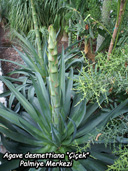 Its
homeland is Mexico where it is not found in the east of
the country. All of the Agave desmettiana
which now grow throughout western USA and Europe
originate from the Sartorius Gardens located in El
Mirador in Veracruz province. Its
homeland is Mexico where it is not found in the east of
the country. All of the Agave desmettiana
which now grow throughout western USA and Europe
originate from the Sartorius Gardens located in El
Mirador in Veracruz province.
Mature leaves of this plant form a rosette 60 90cm in
diameter. The leaves are wide and soft, harder at the
narrow point where they join the trunk of the plant.
The leaves grow upwards and their upper stages take on a
spout-like shape within which is a small trough in which
water collects. Leaves can be a range of different
greens in colour, from a bright green to a more bluey
green. Most specimens have smooth sided leaves but
sometimes a plant will exhibit slightly serrated edges.
The leaves are 50 80cm long and width varies from 8
20cm.
When Agave desmettiana are planted
in the ground they will generally flower 8 10 years
later. The flower stem is 250 300cm in height with
some 20 25 side branches. The flowers are pale green
in colour. After flowering some plants develop aerial
bulbs that called bulbils.
This plant is propagated from seed, from bulbs if they
are formed, or by splitting off new plants growing from
the original. It does need much water. Unlike other
agaves it doesnt like full sun. It thrives in
desert-like conditions in part or full shade. At the
same time it will stand the sun in Mediterranean, but
will also be happy in the shade. It can withstand frost
down to -40C, lower temperatures kill the
plant.
Agave desmettiana
is used in landscaping in the same way as Agave
attenuata: in groups, as edging for a patio, or as a
specimen plant or in small groups within a rock garden.
It is an ideal succulent for temperate areas with its
soft, thorn-free leaves.
|
|

